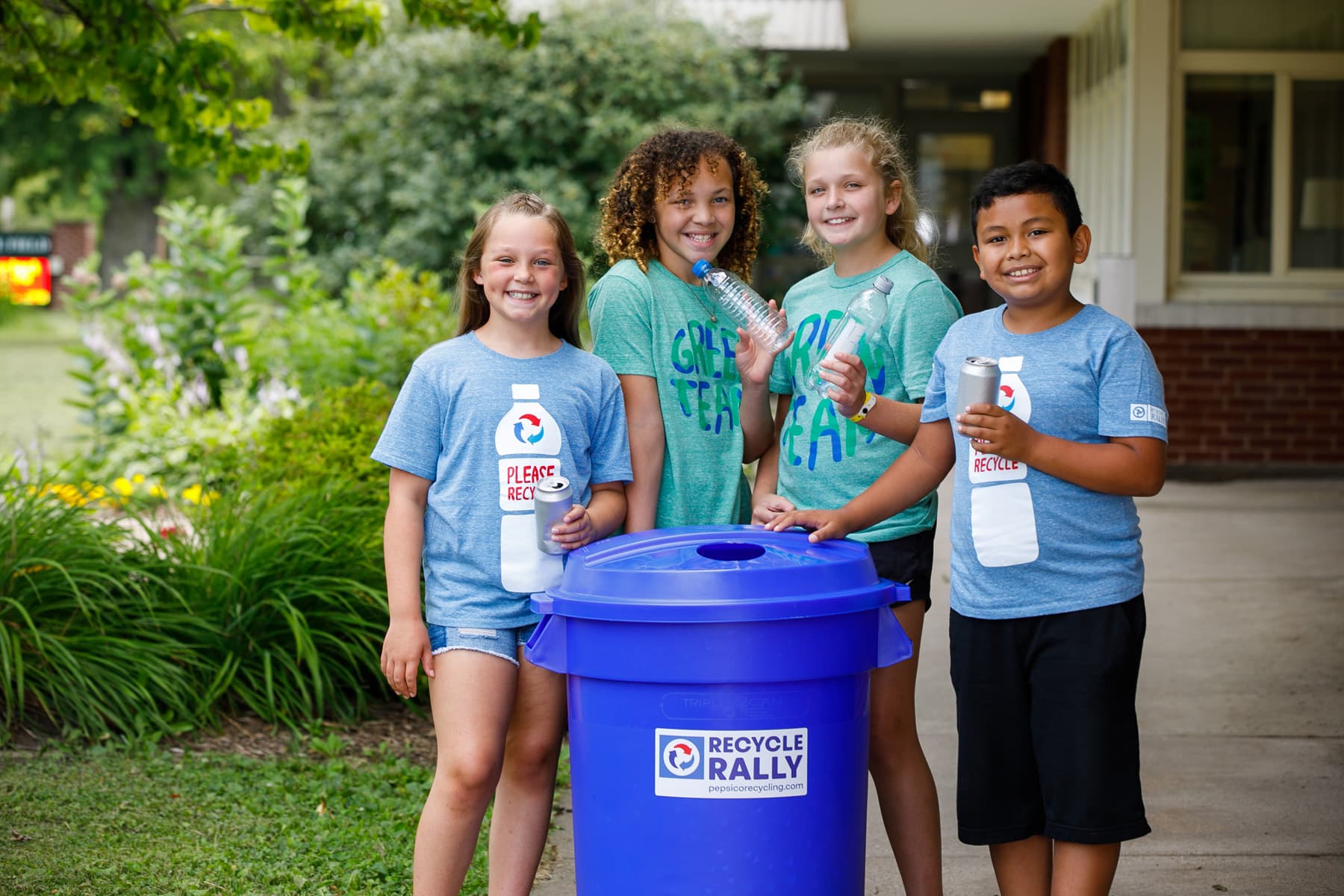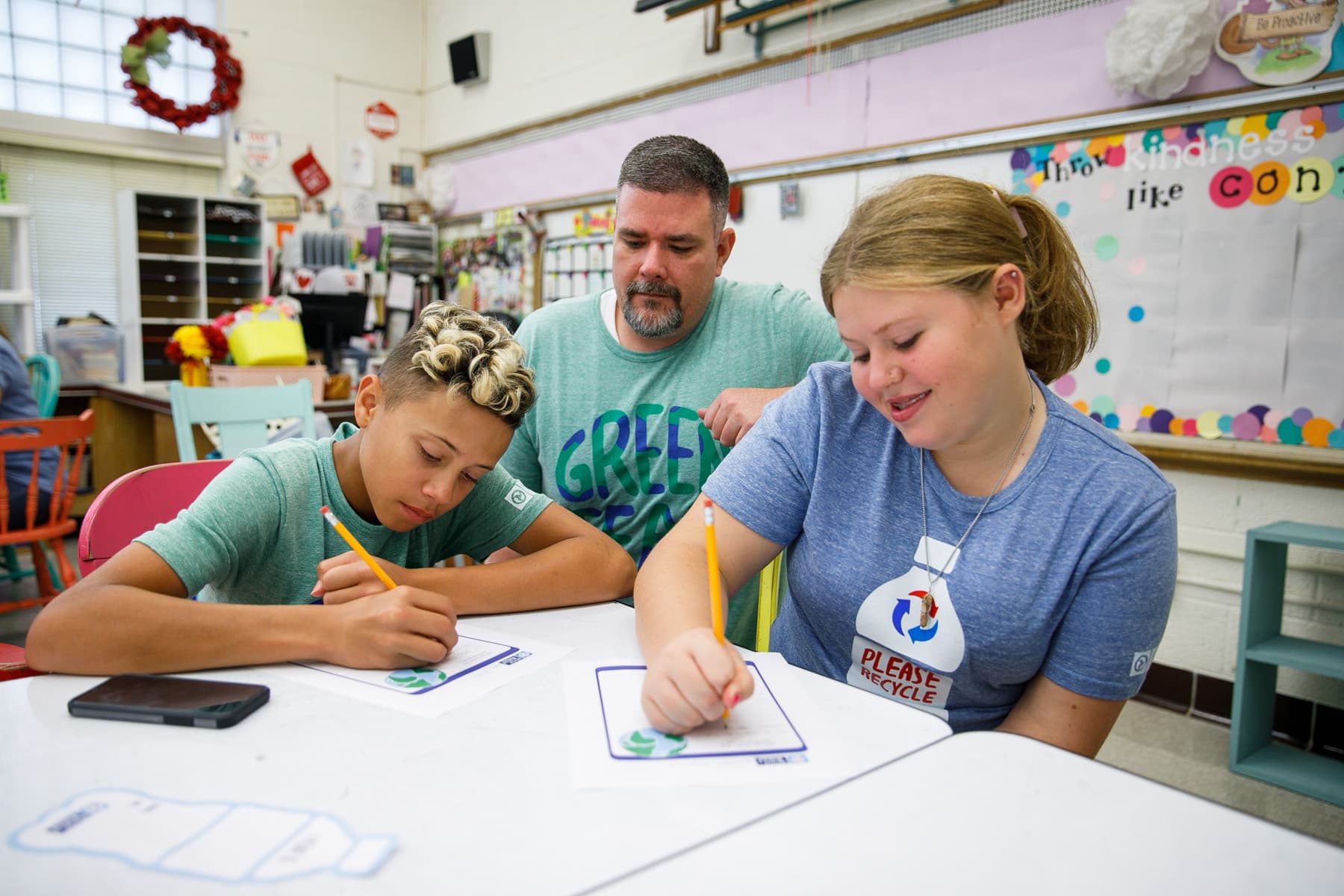Play Recycle Bingo and Learn So Many Recycling Facts
This game is packed with learning.

Use this free printable Recycle Bingo game to teach kids all kinds of facts about recycling and its importance for the planet. The PDF has all the materials you need!
How To Play Recycle Bingo

Here are the basics of Recycle Bingo. Feel free to add your own twist to the rules as you go!
1. Set up the game
Download and print the PDF. Cut apart the recycle bingo cards (consider laminating them for long-term use). Cut apart the Bingo Master Call Sheet icons, then place them in a hat or bowl.
2. Prepare to play
Pass out the Recycle Bingo cards to your students. Provide them with markers like bottlecaps. If you laminated the cards first, they can use dot markers or dry erase markers.
3. Play and learn
Pull an icon card from the hat, and call it out. As students mark their cards, share the fascinating fact that goes along with the card. When a student gets five in a row on their card (across, down, or diagonally), they call out “Bingo!” Check their card to be sure it’s correct, then reward the winner!
Teacher Recycle Bingo Facts
The more your students know about helping out the planet, the more likely they’ll want to get involved! Use these facts as your Recycle Bingo call sheet or just to add a little teachable moment to each bingo call.
Our Planet
Ocean
The EPA says that about one million sea birds, 100,000 sea mammals, and 50,000 fur seals die annually as a result of plastic litter floating in the water. Recycling helps keep these hazardous items away from our oceans.
Sunshine
In one second, our sun produces enough energy to meet the current needs of the entire earth for 500,000 years! Currently, only about one percent of U.S. energy comes from solar power. [EPA]
Wind Power
Wind power dramatically reduces air pollution emissions. The U.S Department of Energy’s Wind Vision Report says that wind can be a viable and affordable source of renewable electricity in all 50 states by 2050. [Energy.gov]
Flower
Flowers bear the responsibility of the survival of plants from one generation to the next. Brightly colored flowers aren’t just beautiful—they are meant to attract birds, bees, and other insects to transfer pollen. [USDA Forest Service]
Rainbow
No two people see the same exact rainbow. It all depends on how the light is being bent and reflected back to you, so everyone sees different images. Someone might look like they are standing underneath a rainbow, when to them, it’s miles away. What a beautiful world. Let’s protect it! [Live Science]
Potted Plant
Help refresh your community by donating healthy plants to public gardens, parks, and schools.
Butterfly
Milkweed plants are the only source of food for the monarch caterpillar, which grows into the beautiful monarch butterfly. Land development and the widespread spraying of weed killer on milkweed fields has dramatically reduced the monarch’s numbers. Fewer pesticides—more butterflies! [Phys.org]
Earth
According to a national survey by PepsiCo Recycling, 40 percent of Americans have a more positive opinion of someone upon learning that they recycle. So it’s true: Love (and recycling) makes the world go round!
River
When trash isn’t properly disposed of, it often reaches our lakes, rivers, and streams—where it can harm ecosystems. Look for those recycling containers! [EPA]
Honeybee
Like eco-conscious recyclers, honeybees are hard at work for our planet’s health. The USDA says that one out of every three bites of food an American takes depends on honeybees and other pollinators!
Beverage Containers
Milk Jug
Think creatively to reuse plastics like milk jugs in your home—like in the garden! Cut one in half, and you have a great dirt scoop. Use the other end as a planter. Look at your green thumb!
Aluminum Can
Aluminum cans have one of the fastest recycling turnaround times and are a great example of recycling power in action. The EPA says cans can actually be recycled into new cans and end up back on your grocer’s shelf in 4–8 weeks.
Plastic Water Bottle
The EPA says only three in ten plastic water bottles get recycled. Recycling plastic bottles produces twice as much energy as burning them in an incinerator.
Plastic Juice Bottle
Rinse your plastic juice bottles before recycling. The remnants usually have sugar and will attract insects and cause odors. Check with your local program to see if you should keep caps and labels on or not (programs vary). [Earth911]
Juice Box Container
Four billion juice boxes are thrown out every year! It’s a little challenging to recycle juice boxes, but it’s still possible! The Carton Council can show you where in your area to recycle your juice boxes. There are special hydro-pulping machines that mash the box into paper pulp, separate out any plastic or aluminum, and turn it into products like toilet paper or plastic pellets. [PBSKids.org]
Glass Bottle
Take the lids off and rinse out your glass bottles before you recycle them. This is especially true if your community doesn’t require glass products to be separated from other recyclables. Otherwise, they may be thrown away at the recycling facility and not properly processed. [Treehugger]
Milk Bottle
Rinse out your milk bottle before recycling but don’t forget the cap! Plastic caps don’t biodegrade, meaning it will take hundreds of years for them to decompose in a landfill. They are usually made of a different plastic than the bottle, so ask your recycling center if they prefer them on or off the bottle. [EPA]
Sports Drink Bottle
The U.S. is recycling less than half of its bottles and cans. According to a PepsiCo national survey, 81 percent of Americans say they would recycle beverage containers if proper bins were available.
Where to Recycle?
Your School
Pop quiz! How does our school recycle now? Do you know which items go in which bins? What do you think we could do as a school community or classroom to improve our effort?
Grocery Store
Only a small percentage of plastic grocery bags end up getting recycled. Make the switch to reusable grocery bags when your family shops and get environmental superstar status! [National Geographic]
The Park
Plan your picnics, barbecues, and weekend fun at sustainable parks with recycling options. Most park districts will have recycling information on their website. Plan to bring home what you brought in (some parks even have carryout laws). Then, recycle your containers at the nearest appropriate facility.
Your Home
Earth911 says that while twice as many families recycle at home than they did 20 years ago, people still get confused about what can and can’t be recycled. When people are unsure about what can be recycled and where, they usually don’t bother. Do some family research together and take action! You got this.
Your Garden
Get composting! We generate 21.5 million tons of food waste each year. If composted, that food would reduce the same amount of greenhouse gas as taking two million cars off the road! [EPA]
Recycling Container
Research by Keep America Beautiful showed that recycling bins are available only 12 percent of the time. How would you make your school or community’s bins more visible? A poster-making party to decorate the sides or smartly placed maps to show bin locations around the school? No idea is too small if it leads to the way to more recycling!
Paper
Newspapers
Clean newspaper (not contaminated with food, grease, or oils) is completely recyclable. If it’s simply wet from the rain, compost it. [Waste Management]
Magazines
The EPA estimates that 1.5 million tons of magazines entered the solid waste stream in 2009, and about 54 percent were recycled. Most paper recycling programs accept magazines. Another way to give them added life is to donate them to a library, school, or a local doctor’s office.
Cardboard Carton
Over half of cardboard collected is used to make new cardboard boxes, cereal boxes, tissue boxes, shoeboxes, etc. Making one ton of new cardboard takes three tons of trees. Recycling one ton of cardboard eliminates nine cubic yards of landfill space. Your cardboard makes a difference! [Earth911]
Mail Supplies (and Junk Mail)
About 40 percent of the solid waste mass that makes up our landfills is paper and cardboard. Recycle supplies you won’t reuse. As for junk mail, Americans receive the equivalent of one and a half trees per year, or approximately 560 pieces of junk mail per year. Yikes! [TreeHugger.com]
Printer Paper
New research shows you’re much more likely to recycle a standard-size piece of paper (an 8 x 11, for example) than an oddly shaped one. Why? Because your mind thinks the standard-size paper is useful, and the smaller, “damaged” one is not. All are recyclable, though! [The Nature Conservancy]
Poster Board
Whether you’re making a Recycle Rally poster or running for student council, poster board counts! More than one-third of all paper fiber used to make paper comes from recycled paper, including poster board. [EPA]
Shipping Box
Maybe there’s something satisfying about breaking down the box. Shipping boxes are among the most frequently recycled paper products (cardboard): 92.9 percent in 2015! Good job, earthlings. [Earth911]
Wrapping Paper
Your gift-wrapping paper can be recycled—but just avoid trying to recycle paper with glitter or metallics as that can contaminate other paper recyclables. Tissue paper is often made from recycled paper. So, keep the cycle going! [TreeHugger.com]
Other Recyclables
Soup Can
Recycling a single soup can saves enough energy to run a television or computer for three hours. [Waste Management]
Soap and Shampoo Bottles
You can treat these plastic bottles like many others—rinse and re-cap or toss the cap, depending on what your local government suggests. Many personal care products are made of plastic #1 and #2. After recycling, these plastics go into cleaning and personal care products as well as piping, cars, and even clothing. [American Chemistry Council]
Condiment Bottles
According to research by the University of Utah, Americans throw away enough plastic bottles each year to circle the Earth four times.
Aluminum Foil
Look for recycled aluminum foil products. This can decrease water and air pollution and reduce energy consumption by 95 percent compared to producing it with raw materials. If you’re recycling it yourself, make sure it’s completely clean. [U.S. Energy Information Administration]
Food Jars and Tubs
Yogurt containers, butter tubs, etc., are perfect to recycle, but it helps recycling facilities if you clean them out a bit first. Consider running containers through the dishwasher. If not, that’s OK. Just use a spatula to get most of the gunk out before you chuck it in the bin. [Recology, San Francisco’s recycling program]
Household Cleaner Bottles
With a good cleaning, most household cleaners, like detergents and disinfectant bottles, are recyclable, too. Most cleaning products are water soluble and safe for school or home disposal. The cleaning residue does not pose a problem for recycling centers. [Earth911]
Electronics
The EPA says that recycling one million laptops saves the energy equivalent of the electricity used by more than 3,500 U.S. homes in a year. Recycling a million cell phones recovers thousands of pounds of reusable materials. Many electronics stores offer in-house or event recycling—check it out!
Batteries
Fifty times more energy is needed to make batteries compared to the amount of energy the batteries can give out—so recycling is key! Recycle them by dropping them off at a designated facility or doing a mail-in or take-back program. Works great for larger communities, like office buildings and schools.[Energy.gov]
If you love Recycle Bingo, be sure to check out this Recycling Quiz Game!
Recycling Bingo
Learn More

Recycle Rally
Recycle Rally is a free K-12 program that provides rewards and tools to help enhance recycling at your school!
Explore now
Additional Resources
Our comprehensive library of resources was designed to inspire the next generation of green leaders.
Explore now


